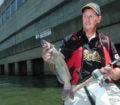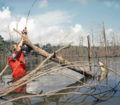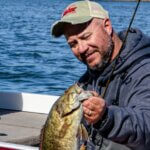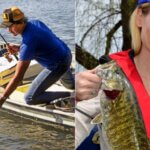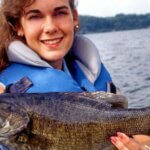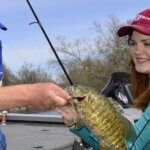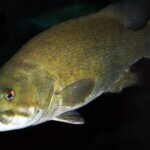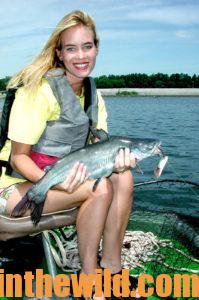 Editor’s Note: Bubbling and swirling, the swift waters of tailraces make anglers think of catfish, feeding in the current’s boils and foam in the highly-oxygenated water. But sometimes those catfish are hard to catch. Several friends of mine have solved the riddle of taking tailrace cats, after perfecting their catfish strategies on the Tennessee River that runs through Tennessee and Alabama. For more than 20 years, they have spent several days a week in the tailrace area watching anglers catch catfish as well as taking catfish themselves. Their tactics will work in tailraces throughout the nation. The key to catching catfish in tailraces is being able to read the water and knowing just where the catfish are. Although catfish roam most tailraces areas below dams because of the abundant baitfish in the water and the highly-oxygenated flow coming through the turbines, some parts of a tailrace will produce more catfish than others. However, productive spots may switch abruptly.
Editor’s Note: Bubbling and swirling, the swift waters of tailraces make anglers think of catfish, feeding in the current’s boils and foam in the highly-oxygenated water. But sometimes those catfish are hard to catch. Several friends of mine have solved the riddle of taking tailrace cats, after perfecting their catfish strategies on the Tennessee River that runs through Tennessee and Alabama. For more than 20 years, they have spent several days a week in the tailrace area watching anglers catch catfish as well as taking catfish themselves. Their tactics will work in tailraces throughout the nation. The key to catching catfish in tailraces is being able to read the water and knowing just where the catfish are. Although catfish roam most tailraces areas below dams because of the abundant baitfish in the water and the highly-oxygenated flow coming through the turbines, some parts of a tailrace will produce more catfish than others. However, productive spots may switch abruptly.
Know the Most-Productive Catfish Baits:
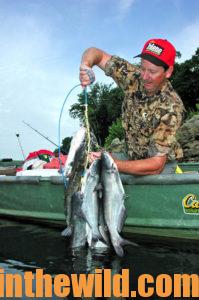 “One of my favorite baits is chicken livers, and I believe that fresh chicken livers are better than frozen chicken livers for catching catfish,” Phil King of Corinth, Mississippi, an avid participant in catfish tournaments nationwide and a guide at Pickwick Lake on the border of Tennessee, Mississippi, and Alabama reports. “A fresh chicken liver is tougher and stronger-smelling and has a better color than a frozen chicken liver. The best chicken liver to catch a catfish with is directly from a processing plant, immediately after it has been removed from a chicken. I never freeze my chicken livers; I always have them on ice to keep them fresh. I don’t leave my chicken livers sitting out in the sun either; I bait-up with them and put the others right back in a cooler. I also use red food coloring in my chicken livers to help the chicken liver hold its natural red color. I also know that red attracts most species of fish. So, I have to believe that the redder I can make my bait, the more attractive it will be to the catfish.
“One of my favorite baits is chicken livers, and I believe that fresh chicken livers are better than frozen chicken livers for catching catfish,” Phil King of Corinth, Mississippi, an avid participant in catfish tournaments nationwide and a guide at Pickwick Lake on the border of Tennessee, Mississippi, and Alabama reports. “A fresh chicken liver is tougher and stronger-smelling and has a better color than a frozen chicken liver. The best chicken liver to catch a catfish with is directly from a processing plant, immediately after it has been removed from a chicken. I never freeze my chicken livers; I always have them on ice to keep them fresh. I don’t leave my chicken livers sitting out in the sun either; I bait-up with them and put the others right back in a cooler. I also use red food coloring in my chicken livers to help the chicken liver hold its natural red color. I also know that red attracts most species of fish. So, I have to believe that the redder I can make my bait, the more attractive it will be to the catfish.
“As for the best baits to fish during extremely-hot weather in the summertime, I like to fish a hickory shad fillet, and this usually will be my No. 1 or No. 2 bait. Anytime I start fishing in the summertime, I’ll have at least one rod with this bait on one of the hooks. I’ve caught more big fish 20 pounds or better on this bait than I have any other bait. My partner in a catfish tournament one time took a 28- and a 38-pound cat in the same day using this bait. Besides catching big fish, this bait is also my favorite for catching large numbers of catfish.
“My No. 2 bait that I’ll always have with me, whether I’m fishing for big cats or large numbers of cats, is fresh chicken livers. The fresher they are, the better they are. At anytime of the year, I’ll usually have a chicken liver down beneath the water when I’m fishing for cats. My No. 3 bait will be the guts of a gizzard shad, cut pieces of gizzard shad and gizzard shad minnows. For my No. 4 bait, many times I’ll cut a 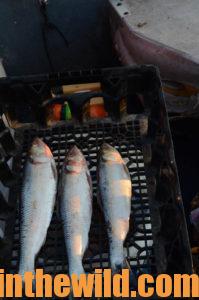 gizzard shad in half and fish with the head or the tail of a gizzard shad. I think the catfish believe that this is a shad that’s been ground-up in the turbines. In hot weather, dip baits are also good, and I’ve caught catfish that weigh up to 19 pounds using dip baits.
gizzard shad in half and fish with the head or the tail of a gizzard shad. I think the catfish believe that this is a shad that’s been ground-up in the turbines. In hot weather, dip baits are also good, and I’ve caught catfish that weigh up to 19 pounds using dip baits.
“If I wasn’t fishing for big cats, but just wanted to catch eating-size cats that would weigh from 1- to 8-pounds each, I’d fish with smaller hooks and fish strictly with chicken livers if I were fishing downriver. If I were fishing near a dam, I’d use either shad guts or shad minnows. When I’m fishing shad minnows near the dam, I’ll fold the shad minnows in half and put one on the hook. Then I’ll fold a second shad minnow in half and put it on the hook. I’ll break the tails and smush the bait, so that the scent from the bait goes out in the water. Then the cats can find the bait much easier. Using smaller hooks and these smushed shad baits, I’ll generally catch channel catfish and blue catfish that will weigh from 1/2-pound to 4 pounds. This bait will also produce flathead catfish.”
Beware of Making Too Much Noise and Methodically Fish Deep Holes:
“During the Dog Days of summer, if you’re fishing in the current below the dam, don’t jig below the dam,” King emphasizes. “You want the bait to move as slowly and as steadily as you can as it floats down the river. All you want to do is raise your lead up off the bottom enough to make sure you’re not hung-up. Let it drift back a little ways, and then lower your sinker down again. The perfect drift when you’re fishing in the current will be for your line to drift back 50-or 60-feet from the boat and bump the bottom, while you hold your boat against the current with a trolling motor. You just want to be able to feel your lead tag the bottom and walk the bait down the bottom with the current.
“Another secret to catching Dog Day cats is that catfish are much more sound-sensitive than most anglers think, especially blue cats. If you run-over the area you want to fish with your boat motor, throw the anchor in and/or drag it across the bottom, and stomp and bang around in the boat or make any loud noises with your boat, you can cause the catfish that will have hit your line to not bite. You also may make catfish that are biting to quit biting. The bigger the catfish is, the more sensitive that fish is to sound.
“When the weather is really hot, another tactic I use for catching hot-water cats is I’ll often go up to the 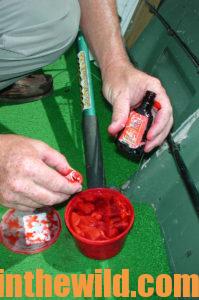 main lake at Pickwick Lake where I fish most of the time. In that deep water that will be from 70- to 80-feet deep, I’ll use Cabela’s rod holders and four to six rods to troll for cats in the holes. I’ll mark the line on each rod with a magic marker and mark four different spots on each line. My first mark will indicate 30 feet of line out. My next marks will be at 40, 50 and finally 60 feet. Once I have the lines marked on all four reels, I’ll put-out lines at different depths from 30-to 60-feet deep. Then I’ll use my trolling motor to move my boat around in those deep holes and try and catch the catfish suspended above those holes. Whichever rod gets the most bites, I’ll notice the depth that I’ve got my baits at by the marks on my line and then set the rest of my rods at that depth.
main lake at Pickwick Lake where I fish most of the time. In that deep water that will be from 70- to 80-feet deep, I’ll use Cabela’s rod holders and four to six rods to troll for cats in the holes. I’ll mark the line on each rod with a magic marker and mark four different spots on each line. My first mark will indicate 30 feet of line out. My next marks will be at 40, 50 and finally 60 feet. Once I have the lines marked on all four reels, I’ll put-out lines at different depths from 30-to 60-feet deep. Then I’ll use my trolling motor to move my boat around in those deep holes and try and catch the catfish suspended above those holes. Whichever rod gets the most bites, I’ll notice the depth that I’ve got my baits at by the marks on my line and then set the rest of my rods at that depth.
“Catfish have a comfort zone, and they’ll suspend at that comfort zone. On different days, that comfort zone may be at various depths. For this reason, each day I fish, I start the same way by fishing four-different depths of water, until I establish a pattern. Perhaps you can see fish on your depth finder. But, many times the fish you see there may not be catfish. By having the drop lines set at different depths, I can let my main line down to the point where I see the band of fish on the depth finder. If they’re catfish, I should be able to get a bite. I’m fishing for and catching suspended catfish, and these catfish are the ones that most people don’t fish for and even fewer people catch. Most anglers believe that cats are bottom feeders and don’t realize that the catfish can feed at any story of the water where the cat locates bait in a comfortable water temperature. But to find and catch those catfish that are suspending, you have to know how to read your depth finder and identify which fish are cats. Too, you also must put your bait in a place where the cats will take it. You’ll most often find suspended cats in lakes and reservoirs more so than you’ll locate them in natural rivers and downstream of major power plants.
 “When I go downriver to fish holes in the river, I think about how to position my boat and how to fish those holes. I’ll start fishing above the hole and bump my baits back with a controlled drift, using my trolling motor so that I can fish in front of the hole first. If the cats are in a feeding mode, they’ll be out of the hole and from 5-to 10-feet out in front of the lip of the break. If they’re not in a feeding mode, they’ll be down in the hole. So, as I bump my bait up off the bottom, I’ll let the lead drop-off into the hole and should find a catfish there. As I drift-down the hole, I’ll look for a boulder, a tree, a log or maybe a second drop-off in the hole where cats often will be staging. Remember, I define a hole in the bottom as a small depression that may only be 4-or 5-feet wide and 6-to 10-feet long, or it may be a deep bottom break that runs for 1/2-mile down the river.”
“When I go downriver to fish holes in the river, I think about how to position my boat and how to fish those holes. I’ll start fishing above the hole and bump my baits back with a controlled drift, using my trolling motor so that I can fish in front of the hole first. If the cats are in a feeding mode, they’ll be out of the hole and from 5-to 10-feet out in front of the lip of the break. If they’re not in a feeding mode, they’ll be down in the hole. So, as I bump my bait up off the bottom, I’ll let the lead drop-off into the hole and should find a catfish there. As I drift-down the hole, I’ll look for a boulder, a tree, a log or maybe a second drop-off in the hole where cats often will be staging. Remember, I define a hole in the bottom as a small depression that may only be 4-or 5-feet wide and 6-to 10-feet long, or it may be a deep bottom break that runs for 1/2-mile down the river.”
Understand the Times Big Catfish Bite Best:
“Fishing for big catfish is better at night near the dams, if the catfish have already spawned and have moved-up,” King mentions. “If the catfish haven’t spawned, your chances of catching the big ones are 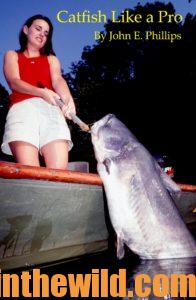 better fishing during daylight in the holes in the river. In the hottest part of the summer, the big cats either have got to be by the dam or in holes in the river to dodge the heat and to feed. I believe the big cats are most likely to be caught from noon to dusk. The big catfish have been moving and feeding all night, and I think they’re getting ready to snack or feed heavily from 12:00 noon to dusk. My favorite time to fish, however, is an hour or two after daylight. I believe the secondary peak time will be from 8:30 am until 10:30 am when you may find cats still feeding from the previous night.”
better fishing during daylight in the holes in the river. In the hottest part of the summer, the big cats either have got to be by the dam or in holes in the river to dodge the heat and to feed. I believe the big cats are most likely to be caught from noon to dusk. The big catfish have been moving and feeding all night, and I think they’re getting ready to snack or feed heavily from 12:00 noon to dusk. My favorite time to fish, however, is an hour or two after daylight. I believe the secondary peak time will be from 8:30 am until 10:30 am when you may find cats still feeding from the previous night.”
To learn more about catching catfish, check out John E. Phillips’ book, “Catfish Like a Pro,” available in Kindle and paperback, at http://amzn.to/W900eu. You can also get a free eBook copy of “The Catfish Catcher’s Cookbook” at https://johninthewild.com/free-books.

